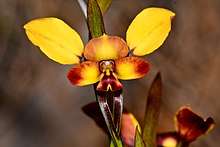Diuris porrifolia
Diuris porrifolia, commonly called the small-flowered donkey orchid[2] is a species of orchid which is endemic to the south-west of Western Australia. It has two or three leaves and up to seven yellow flowers with brown or reddish markings. It is similar to the common donkey orchid (D. corymbosa) but its flowers are smaller and it has a more easterly distribution.
| Small-flowered donkey orchid | |
|---|---|
 | |
| Diuris porrifolia growing in Wandoo National Park | |
| Scientific classification | |
| Kingdom: | Plantae |
| Clade: | Tracheophytes |
| Clade: | Angiosperms |
| Clade: | Monocots |
| Order: | Asparagales |
| Family: | Orchidaceae |
| Subfamily: | Orchidoideae |
| Tribe: | Diurideae |
| Genus: | Diuris |
| Species: | D. porrifolia |
| Binomial name | |
| Diuris porrifolia | |
| Synonyms[1] | |
Description
Diuris porrifolia is a tuberous, perennial herb with two or three leaves 100–200 mm (4–8 in) long and 8–13 mm (0.3–0.5 in) wide. There are up to seven yellow flowers with brown or reddish markings, 18–25 mm (0.7–1 in) long and wide on a flowering stem 150–350 mm (6–10 in) high. The dorsal sepal is erect, 7–10 mm (0.3–0.4 in) long and 8–10 mm (0.3–0.4 in) wide. The lateral sepals point downwards, 15–19 mm (0.6–0.7 in) long and about 3 mm (0.1 in) wide. The petals are more or less erect, 10–13 mm (0.4–0.5 in) long and 5–7 mm (0.2–0.3 in) wide on a stalk 4–6 mm (0.16–0.24 in) long. The middle lobe of the labellum is wedge-shaped with a central fold, 5–6 mm (0.20–0.24 in) long and 4.5 mm (0.2 in) wide and the side lobes are 6–8 mm (0.2–0.3 in) long and 3–4 mm (0.1–0.2 in) wide. Flowering occurs from late July to September.[2][3][4]
This species is similar to D. corymbosa but has smaller flowers and a more easterly distribution. It has also been confused with the recently described (2016) western wheatbelt donkey orchid (D. brachyscapa) which has larger flowers and a more westerly distribution.[3]
Taxonomy and naming
Diuris porrifolia was first formally described in 1840 by John Lindley and the description was published in A Sketch of the Vegetation of the Swan River Colony as an appendix to Edwards's Botanical Register.[1][5] The specific epithet (porrifolia) is derived from the Latin words porrum meaning "a leek"[6]:626 and folia meaning "leaves",[6]:466 referring to the shape of the leaves of this species.[3]
The Index Kewensis lists this name as a synonym of Diuris corymbosa.[7]
Distribution and habitat
The small-flowered donkey orchid occurs between Perth and Boyup Brook where it grows in woodland and forest.[2][3]
Conservation
Diuris porrifolia is classified as "not threatened" by the Western Australian Government Department of Parks and Wildlife.[8]
References
- "Duiris porrifolia". APNI. Retrieved 23 June 2018.
- Jones, David L. (2006). A complete guide to native orchids of Australia including the island territories. Frenchs Forest, N.S.W.: New Holland. pp. 135–136. ISBN 1877069124.
- Brown, Andrew; Dixon, Kingsley; French, Christopher; Brockman, Garry (2013). Field guide to the orchids of Western Australia : the definitive guide to the native orchids of Western Australia. Simon Nevill Publications. p. 209. ISBN 9780980348149.
- Hoffman, Noel; Brown, Andrew (2011). Orchids of South-West Australia (3rd ed.). Gooseberry Hill: Noel Hoffman. p. 466. ISBN 9780646562322.
- Lindley, John (1840). A Sketch of the Vegetation of the Swan River Colony (Appendix). Piccadilly, London: James Ridgway. p. 51. Retrieved 23 June 2018.
- Brown, Roland Wilbur (1956). The Composition of Scientific Words. Washington, D.C.: Smithsonian Institution Press.
- "Diuris corymbosa". World Checklist of Selected Plant Families (WCSP). Royal Botanic Gardens, Kew.
- "Diuris porrifolia". FloraBase. Western Australian Government Department of Parks and Wildlife.